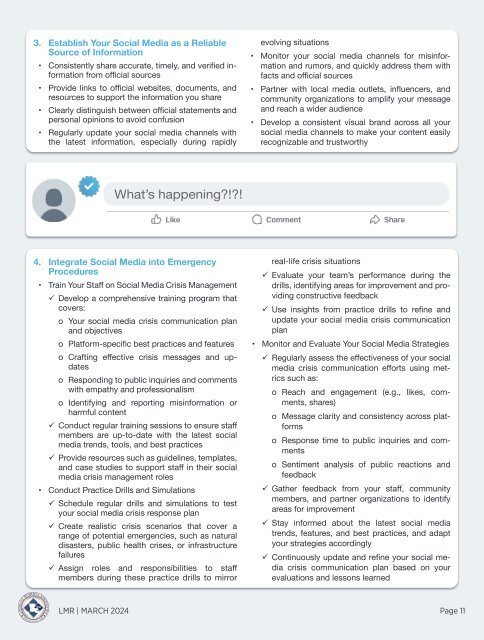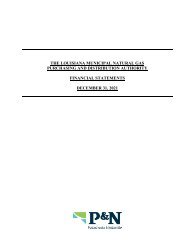MARCH 2024
Create successful ePaper yourself
Turn your PDF publications into a flip-book with our unique Google optimized e-Paper software.
3. Establish Your Social Media as a Reliable<br />
Source of Information<br />
• Consistently share accurate, timely, and verified information<br />
from official sources<br />
• Provide links to official websites, documents, and<br />
resources to support the information you share<br />
• Clearly distinguish between official statements and<br />
personal opinions to avoid confusion<br />
• Regularly update your social media channels with<br />
the latest information, especially during rapidly<br />
evolving situations<br />
• Monitor your social media channels for misinformation<br />
and rumors, and quickly address them with<br />
facts and official sources<br />
• Partner with local media outlets, influencers, and<br />
community organizations to amplify your message<br />
and reach a wider audience<br />
• Develop a consistent visual brand across all your<br />
social media channels to make your content easily<br />
recognizable and trustworthy<br />
What’s happening?!?!<br />
4. Integrate Social Media into Emergency<br />
Procedures<br />
• Train Your Staff on Social Media Crisis Management<br />
Develop a comprehensive training program that<br />
covers:<br />
o Your social media crisis communication plan<br />
and objectives<br />
o Platform-specific best practices and features<br />
o Crafting effective crisis messages and updates<br />
o Responding to public inquiries and comments<br />
with empathy and professionalism<br />
o Identifying and reporting misinformation or<br />
harmful content<br />
Conduct regular training sessions to ensure staff<br />
members are up-to-date with the latest social<br />
media trends, tools, and best practices<br />
Provide resources such as guidelines, templates,<br />
and case studies to support staff in their social<br />
media crisis management roles<br />
• Conduct Practice Drills and Simulations<br />
Schedule regular drills and simulations to test<br />
your social media crisis response plan<br />
Create realistic crisis scenarios that cover a<br />
range of potential emergencies, such as natural<br />
disasters, public health crises, or infrastructure<br />
failures<br />
Assign roles and responsibilities to staff<br />
members during these practice drills to mirror<br />
real-life crisis situations<br />
Evaluate your team’s performance during the<br />
drills, identifying areas for improvement and providing<br />
constructive feedback<br />
Use insights from practice drills to refine and<br />
update your social media crisis communication<br />
plan<br />
• Monitor and Evaluate Your Social Media Strategies<br />
Regularly assess the effectiveness of your social<br />
media crisis communication efforts using metrics<br />
such as:<br />
o Reach and engagement (e.g., likes, comments,<br />
shares)<br />
o Message clarity and consistency across platforms<br />
o Response time to public inquiries and comments<br />
o Sentiment analysis of public reactions and<br />
feedback<br />
Gather feedback from your staff, community<br />
members, and partner organizations to identify<br />
areas for improvement<br />
Stay informed about the latest social media<br />
trends, features, and best practices, and adapt<br />
your strategies accordingly<br />
Continuously update and refine your social media<br />
crisis communication plan based on your<br />
evaluations and lessons learned<br />
LMR | <strong>MARCH</strong> <strong>2024</strong> Page 11
















